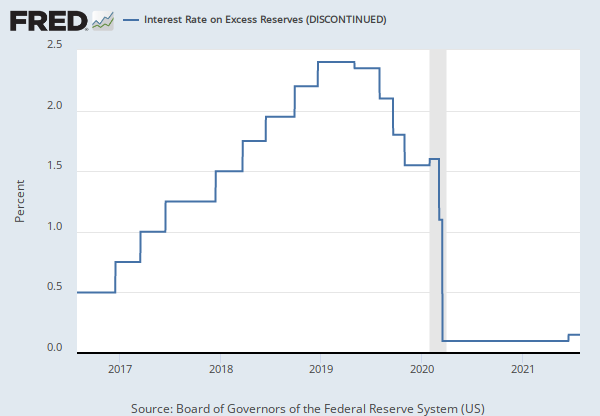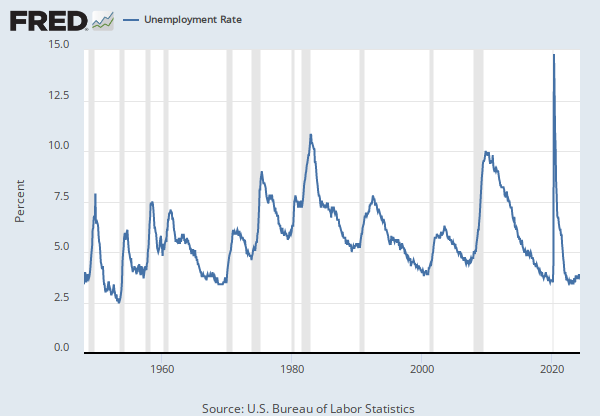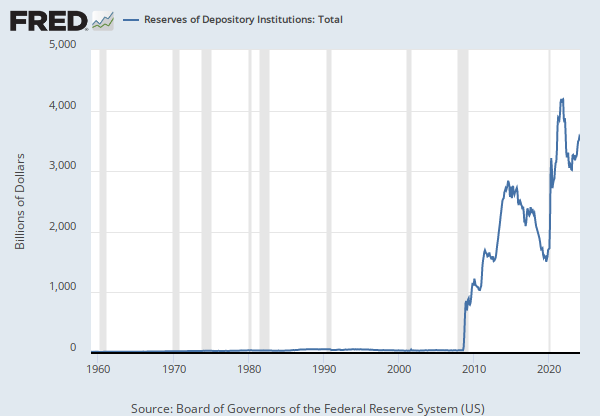Federal Reserve Economic Data
- Release Calendar
- FRED Tools
- FRED News
- FRED Blog
- About FRED
Data in this graph are copyrighted. Please review the copyright information in the series notes before sharing.
NOTES
Source: Board of Governors of the Federal Reserve System (US)
Release: Interest Rate on Reserve Balances
Units: Percent, Not Seasonally Adjusted
Frequency: Weekly, Ending Wednesday
Notes:
This series has been discontinued due to changes in Regulation D. On June 27, 2013, all depository institutions have a common two-week maintenance period. A maintenance period is the period of time over which depository institutions maintain balances at a Federal Reserve Bank, either directly or through a pass-through correspondent, to satisfy reserve balance requirements. A common two-week maintenance period consists of 14 consecutive days beginning on a Thursday and ending on the second Wednesday thereafter. The first two-week maintenance period began on June 27, 2013. For more information see http://www.federalreserve.gov/monetarypolicy/reqresbalances.htm
Suggested Citation:
Board of Governors of the Federal Reserve System (US), Interest Rate Paid on Excess Reserve Balances (Institutions with 1-Week Maintenance Period) (DISCONTINUED) [INTEXC1], retrieved from FRED, Federal Reserve Bank of St. Louis; https://fred.stlouisfed.org/series/INTEXC1, .
Source: Board of Governors of the Federal Reserve System (US)
Release: Interest Rate on Reserve Balances
Units: Percent, Not Seasonally Adjusted
Frequency: Biweekly, Ending Wednesday
Notes:
This series has been discontinued due to changes in Regulation D. Effective with the common two-week maintenance period starting on June 27, 2013, balances maintained that exceed the top of the penalty-free band will be remunerated at the interest rate to be paid on excess balances. The new series is at https://fred.stlouisfed.org/series/INTRESEXCW?rid=19
Suggested Citation:
Board of Governors of the Federal Reserve System (US), Interest Rate Paid on Excess Reserve Balances (Institutions with 2-Week Maintenance Period) (DISCONTINUED) [INTEXC2], retrieved from FRED, Federal Reserve Bank of St. Louis; https://fred.stlouisfed.org/series/INTEXC2, .
Source: Board of Governors of the Federal Reserve System (US)
Release: H.3 Aggregate Reserves of Depository Institutions and the Monetary Base
Units: Percent, Not Seasonally Adjusted
Frequency: Weekly, Ending Wednesday
Notes:
Balances maintained to satisfy reserve balance requirements up to and including the top of the penalty-free band are remunerated at the rate paid on balances maintained up to the top of the penalty-free band.
Effective February 2, 1984, reserve computation and maintenance periods have been changed from weekly to bi-weekly. Series with data prior to February 2, 1984 have different values reported from one week to the next. After February 2, 1984, the value repeats for 2 consecutive weeks.
Effective July 23, 2015, the Federal Reserve Board changed the formula for calculating interest for depository institutions with excess balances. The new formula is based on the daily interest rate on excess reserves (IOER rate) and the daily balance maintained, rather than the maintenance period IOER rate and the average balance maintained over the maintenance period. The IOER and IORR rates effective for a given day are now published on the "Interest on Required Balances and Excess Balances" page on the Federal Reserve Board's website at http://www.federalreserve.gov/monetarypolicy/reqresbalances.htm
Suggested Citation:
Board of Governors of the Federal Reserve System (US), Interest Rate Paid on Balances Maintained to Satisfy Reserve Balance Requirements (DISCONTINUED) [INTRESREQW], retrieved from FRED, Federal Reserve Bank of St. Louis; https://fred.stlouisfed.org/series/INTRESREQW, .
Source: Board of Governors of the Federal Reserve System (US)
Release: Interest Rate on Reserve Balances
Units: Percent, Not Seasonally Adjusted
Frequency: Weekly, Ending Wednesday
Notes:
This series has been discontinued due to changes in Regulation D. On June 27, 2013, all depository institutions have a common two-week maintenance period. A maintenance period is the period of time over which depository institutions maintain balances at a Federal Reserve Bank, either directly or through a pass-through correspondent, to satisfy reserve balance requirements. A common two-week maintenance period consists of 14 consecutive days beginning on a Thursday and ending on the second Wednesday thereafter. The first two-week maintenance period began on June 27, 2013. For more information see http://www.federalreserve.gov/monetarypolicy/reqresbalances.htm
Suggested Citation:
Board of Governors of the Federal Reserve System (US), Interest Rate Paid on Required Reserve Balances (Institutions with 1-Week Maintenance Period) (DISCONTINUED) [INTREQ1], retrieved from FRED, Federal Reserve Bank of St. Louis; https://fred.stlouisfed.org/series/INTREQ1, .
Source: Board of Governors of the Federal Reserve System (US)
Release: Interest Rate on Reserve Balances
Units: Percent, Not Seasonally Adjusted
Frequency: Biweekly, Ending Wednesday
Notes:
This series has been discontinued due to changes in Regulation D. Effective with the common two-week maintenance period starting on June 27, 2013, balances maintained to satisfy reserve balance requirements up to and including the top of the penalty-free band will be remunerated at the rate paid on balances maintained up to the top of the penalty-free band. The new series is at https://fred.stlouisfed.org/series/INTRESREQW
Suggested Citation:
Board of Governors of the Federal Reserve System (US), Interest Rate Paid on Required Reserve Balances (Institutions with 2-Week Maintenance Period) (DISCONTINUED) [INTREQ2], retrieved from FRED, Federal Reserve Bank of St. Louis; https://fred.stlouisfed.org/series/INTREQ2, .
Source: Board of Governors of the Federal Reserve System (US)
Release: H.15 Selected Interest Rates
Units: Percent, Not Seasonally Adjusted
Frequency: Daily, 7-Day
Notes:
For additional historical federal funds rate data, please see Daily Federal Funds Rate from 1928-1954.
The federal funds rate is the interest rate at which depository institutions trade federal funds (balances held at Federal Reserve Banks) with each other overnight. When a depository institution has surplus balances in its reserve account, it lends to other banks in need of larger balances. In simpler terms, a bank with excess cash, which is often referred to as liquidity, will lend to another bank that needs to quickly raise liquidity. (1) The rate that the borrowing institution pays to the lending institution is determined between the two banks; the weighted average rate for all of these types of negotiations is called the effective federal funds rate.(2) The effective federal funds rate is essentially determined by the market but is influenced by the Federal Reserve through open market operations to reach the federal funds rate target.(2)
The Federal Open Market Committee (FOMC) meets eight times a year to determine the federal funds target rate. As previously stated, this rate influences the effective federal funds rate through open market operations or by buying and selling of government bonds (government debt).(2) More specifically, the Federal Reserve decreases liquidity by selling government bonds, thereby raising the federal funds rate because banks have less liquidity to trade with other banks. Similarly, the Federal Reserve can increase liquidity by buying government bonds, decreasing the federal funds rate because banks have excess liquidity for trade. Whether the Federal Reserve wants to buy or sell bonds depends on the state of the economy. If the FOMC believes the economy is growing too fast and inflation pressures are inconsistent with the dual mandate of the Federal Reserve, the Committee may set a higher federal funds rate target to temper economic activity. In the opposing scenario, the FOMC may set a lower federal funds rate target to spur greater economic activity. Therefore, the FOMC must observe the current state of the economy to determine the best course of monetary policy that will maximize economic growth while adhering to the dual mandate set forth by Congress. In making its monetary policy decisions, the FOMC considers a wealth of economic data, such as: trends in prices and wages, employment, consumer spending and income, business investments, and foreign exchange markets.
The federal funds rate is the central interest rate in the U.S. financial market. It influences other interest rates such as the prime rate, which is the rate banks charge their customers with higher credit ratings. Additionally, the federal funds rate indirectly influences longer- term interest rates such as mortgages, loans, and savings, all of which are very important to consumer wealth and confidence.(2)
References
(1) Federal Reserve Bank of New York. "Federal funds." Fedpoints, August 2007.
(2) Monetary Policy, Board of Governors of the Federal Reserve System.
Suggested Citation:
Board of Governors of the Federal Reserve System (US), Federal Funds Effective Rate [DFF], retrieved from FRED, Federal Reserve Bank of St. Louis; https://fred.stlouisfed.org/series/DFF, .






































